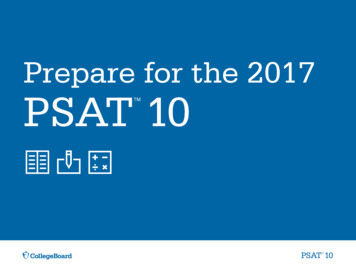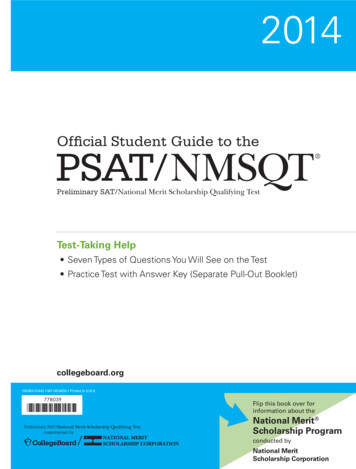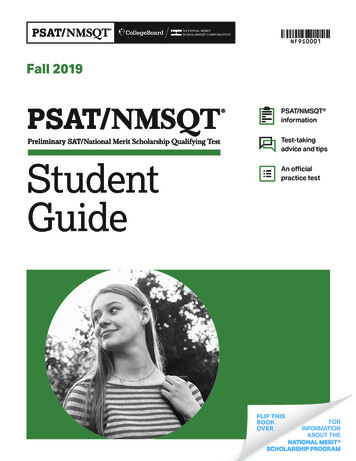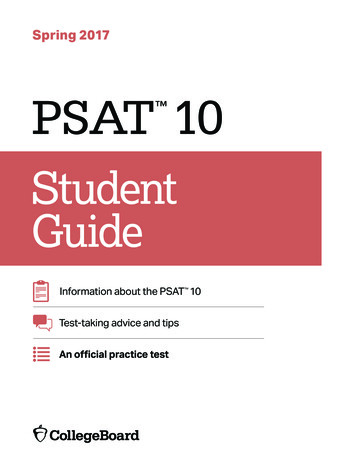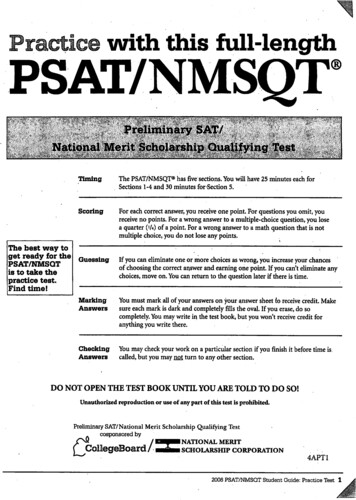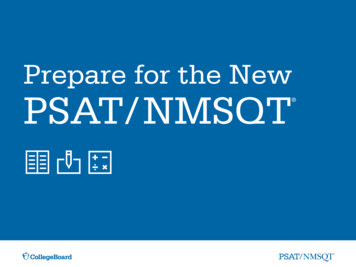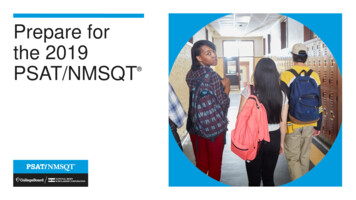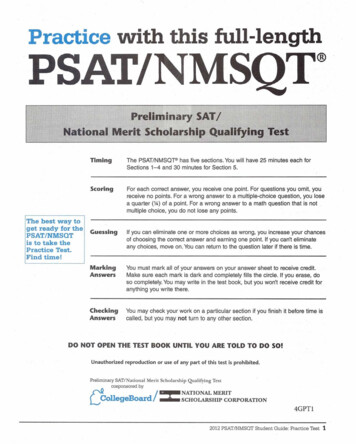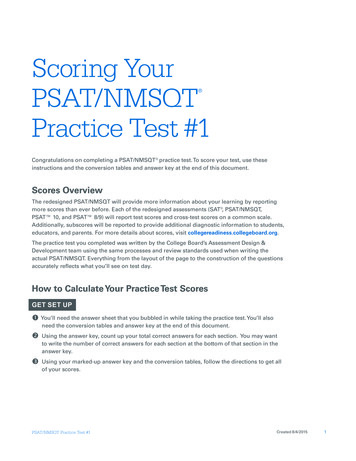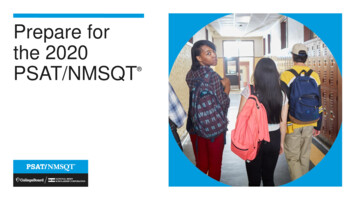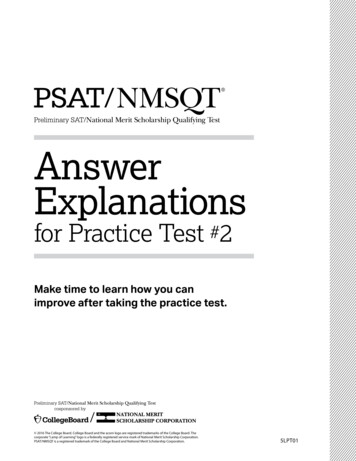
Transcription
AnswerExplanationsfor Practice Test #2Make time to learn how you canimprove after taking the practice test. 2016 The College Board. College Board and the acorn logo are registered trademarks of the College Board. Thecorporate “Lamp of Learning” logo is a federally registered service mark of National Merit Scholarship Corporation.PSAT/NMSQT is a registered trademark of the College Board and National Merit Scholarship Corporation.5LPT01
PSAT/NMSQT ANSWER EXPLANATIONS READINGPSAT/NMSQT Practice Test #2Reading Test Answer ExplanationsQuestion 1Choice A is the best answer. Falvo believes that when tryingsomething new it’s important to not overdo it. This can be seenmost clearly when Falvo admonishes the newest runner to controlhis impulses and not to run too fast or try too hard when racing withmore experienced runners: “I don’t want you doing anything stupid,Mosher. Some of these boys have been at it for a while. Don’t thinkabout them, think about yourself” (lines 19-22).KEY: ADIFFICULTY: EasyChoice B is incorrect because McCann is described as a “toughlooking kid [who] smiled like a gunslinger” (lines 17-18), implyingthat he is a risk-taker who is likely to push limits. Choice C isincorrect because in the passage Mosher pushes himself until hemakes himself physically sick. Choice D is incorrect because theperson who said “let him go” was watching Mosher “stagger” pastafter he had already pushed himself past his limits.Question 2Choice B is the best answer. The previous question asks whichcharacter believes one shouldn’t push his or her limits when tryingsomething new: the running coach Falvo. The best evidence insupport of that choice is lines 19-22, when Falvo instructs Mosher tocontrol himself when running with the experienced racers by saying“I don’t want you doing anything stupid, Mosher. Some of theseboys have been at it for a while. Don’t think about them, think aboutyourself.”KEY: BDIFFICULTY: MediumChoice A is incorrect because while lines 14-17 show Falvoencouraging McCann not to “drain the well,” they do not addressthe issue of McCann “trying something new,” which is a centralpart of the previous question. Choices C and D are incorrect becauselines 55-60 and 76-79 both show that Mosher pushed himself toohard, not that he controlled himself.Question 3Choice B is the best answer. “Pace yourself. Let them do what theydo. They’ll be about thirty yards ahead after the first lap. Don’tworry about them. Go out slow, feel your way, then bring it home asbest you can. OK?” (lines 24-27). These lines indicate Falvo believesMosher should run for himself and not focus on what the other,more experienced runners in the time trial are doing. The mainKEY: BDIFFICULTY: Medium2
PSAT/NMSQT ANSWER EXPLANATIONS READINGpurpose of these lines is to reemphasize what Falvo had said earlierin the passage about not overdoing it when trying new things.Choice A is incorrect because lines 24-27 were addressedspecifically to Mosher, not the group. Choice C is incorrect becauselines 24-27 are instructions to one runner about a specific race.Choice D is incorrect because lines 24-27 do not reveal anythingabout Falvo’s beliefs as much as they repeat or reemphasize whathe had said earlier.Question 4Choice B is the best answer. In the passage, the narrator, Mosher,shrugged after Falvo told him not to do anything stupid and thensaid “sure” when the coach warned him not to worry about theother runners, responses that both indicate that Mosher wasignoring the coach’s advice (or being dismissive of it).KEY: BDIFFICULTY: EasyChoices A, C, and D are incorrect because when Mosher shrugsat or offers a one-word response to the coach’s advice, it can beinferred that he is simply ignoring it, not that he is a shy, dishonest,or hostile person.Question 5Choice C is the best answer. Falvo’s advice to the runners at thebeginning of the passage was not to push themselves too hard.Even if the more experienced runners did not verbally respond tothat advice, it’s clear they followed it because their running wasdescribed throughout the passage as having a “quiet, aggressive,sustained power that looked like nothing” (lines 38-39) and beingas “smooth as water” (line 42). When passing Mosher on the track,those runners were also said to be “all business now” (line 55),describing efficiency without too much effort; those runners werenot pushing themselves too hard.KEY: CDIFFICULTY: MediumChoices A, B, and D are incorrect because the passage never stateshow the more experienced runners responded to Falvo’s advice(except for McCann’s smiling at the idea he shouldn’t “drain thewell” that day), so it’s impossible to know if those runners wereenthusiastic about it, ignored it, or only pretended to heed it.However, the way those racers were said to have run the time trial(“all business”) does show that they generally accepted what theircoach had said.Question 6Choice D is the best answer. The passage makes clear that Mosherignores Falvo’s advice to stay contained as a runner during the timetrial. Later he makes it clear that he had no idea why he hadn’tKEY: DDIFFICULTY: Hard3
PSAT/NMSQT ANSWER EXPLANATIONS READINGfollowed Falvo’s advice: “I don’t know why. I can’t explain it” (line61).Choices A, B, and C are incorrect because line 61 is explicit instating that the narrator did not have a good reason to ignoreFalvo’s advice, not that he did so just because he was determinedto keep up with the other runners, wanted to prove something tohimself, or wanted to improve on his previous time.Question 7Choice B is the best answer. The previous question asks forMosher’s motivation for pushing himself too hard in the time trial.In line 61, Mosher offers no concrete explanation for why he ran thetime trial the way he did: “I don’t know why. I can’t explain it.”KEY: BDIFFICULTY: HardChoice A is incorrect because lines 36-39 describe the other runnersin the time trial but not the narrator. Choice C is incorrect becauselines 73-76 explain Mosher’s physical condition, not his internalmotivation, at the end of the time trial. Choice D is incorrectbecause lines 91-94 explain Falvo’s reaction to Mosher’s race.Question 8Choice A is the best answer. Falvo says to the exhausted Mosher:“‘What we have here,’ he was saying, ‘is a failure to communicate.Stay within yourself, I said. Don’t drain the well, I said’” (lines 8183). By then Mosher had pushed himself so hard that he’d becomephysically ill and used up all his energy.KEY: ADIFFICULTY: EasyChoice B is incorrect because “don’t drain the well” means don’tuse up the valuable energy one has, not “don’t get sick.” ChoicesC and D are incorrect because in the passage Falvo tells Mosher tomaintain his own pace and run his own race, not that he should beconcerned with the other runners or that he shouldn’t quit if tired.Question 9Choice D is the best answer. Lines 88-89 state “He laughed—that bitter Falvo laugh—ha!—like he’d just been vindicated.”“Vindicated” means to be justified or proven correct, which isapt in this context because by running himself into sickness andexhaustion, Mosher had proven correct Falvo’s belief that Moshermight overdo it.KEY: DDIFFICULTY: MediumChoice A is incorrect because “avenged” means to exact vengeanceor satisfaction. Choices B and C are incorrect because in thispassage no one is either set free or defended against; rather, Falvois simply proven correct that Mosher might push too hard in thetime trial.4
PSAT/NMSQT ANSWER EXPLANATIONS READINGQuestion 10Choice A is the best answer. The passage begins with “thenumber of democracies in the world today is unprecedented” andthen continues in the second paragraph by providing the specificnumbers in support of that claim: lines 17-20 state that in 2011,117 of 193 countries were identified as electoral democraciesbut that only 69 of 167 countries had been so labeled in 1989.Beginning in line 23, however, the passage moves away from thesimple claim that the number of political democracies in the worldwas increasing (unprecedented) and begins to analyze the reasonfor that change: “What caused this global transformation?” Theremainder of the passage then focuses more closely on the reasonsthere are more democracies today, including the “local factors” (line24) involved, “poor economic management by many authoritariangovernments” (lines 26-27), and “new reach and speed of massmedia” (lines 37-38).KEY: ADIFFICULTY: MediumChoice B is incorrect because the passage doesn’t claim there isless political openness in the world but more. Choice C is incorrectbecause the passage doesn’t start with one set of data and thenswitch to a conflicting set. Choice D is incorrect because thepassage neither supports nor denounces either democracies orautocracies but simply discusses their increasing and/or decreasingnumbers in the modern world.Question 11Choice D is the best answer. Lines 17-20 state that in 2011, 117 of193 surveyed countries were identified as electoral democracies butthat only 69 of 167 countries were labeled as such in 1989. Thenthose statistics are further explained by being “put another way”(line 20), or stated another way.KEY: DDIFFICULTY: EasyChoices A, B, and C are incorrect because to “put” the statisticsin lines 17-20 “another way” means to explain or state themanother way, not to inflict something on someone by will or force(“impose”), physically set something up (“place”), or encourage orarouse (“incite”).Question 12Choice D is the best answer. Lines 30-31 explain that one waydemocracy was supported around the world was that “Westerngovernments and activists encouraged dissent and held outrewards for reform.” In this context, the rewards being “held out”(line 31) means the rewards being offered.KEY: DDIFFICULTY: EasyChoices A, B, and C are incorrect because the rewards being “heldout” by Western governments and activists refer to the rewards5
PSAT/NMSQT ANSWER EXPLANATIONS READINGbeing offered, not that those rewards were being resisted, awaited,or avoided.Question 13Choice D is the best answer. Lines 56-59 state that “according toone study of the world’s democratic electoral systems, Brunei maybe the only country where ‘electoral politics has failed to put downany meaningful roots at all.’” These lines support the claim thatthere’s been a global trend toward political openness as they makeclear that there’s only one country on Earth (Brunei) where suchopenness cannot be found.KEY: DDIFFICULTY: HardChoice A is incorrect because line 23 asks a question related to theproportion of democracies in the world but nothing about “politicalopenness.” Choice B is incorrect because lines 26-27 explain onereason authoritarian regimes have failed. Choice C is incorrectbecause lines 41-42 address the factor of the modern media inpolitics.Question 14Choice A is the best answer. While the passage states and supportsthe idea that there are more democracies and fewer autocraciesin the world today, it further explains that, perhaps surprisingly,even those autocracies are becoming more open: “With far fewerrepressive regimes in the world, one might have expected theholdouts to be places where freedom and political competition areincreasingly suppressed. But in fact the opposite is true” (lines 5963).KEY: ADIFFICULTY: MediumChoices B, C, and D are incorrect because in lines 59-63, the passageexplicitly supports the idea that freedom in modern autocracies isnot being “increasingly suppressed” (“in fact the opposite is true”),but the passage says nothing about conflicting data and opinionpolls regarding life in those autocracies (choice B), that democracyhas faced a number of local setbacks (choice C), or that politicalopenness in autocratic countries has declined (choice D).Question 15Choice C is the best answer. The previous question asks about theunexpected state of political openness in autocratic regimes, withlines 59-63 clearly explaining that there is more political openness tobe found in those regimes than might have been assumed: “With farfewer repressive regimes in the world, one might have expected theholdouts to be places where freedom and political competition areincreasingly suppressed. But in fact the opposite is true.”KEY: CDIFFICULTY: Hard6
PSAT/NMSQT ANSWER EXPLANATIONS READINGChoices A, B, and D are incorrect because the previous questionasks about how politically open modern autocratic regimes tendto be, but lines 18-22 discuss the proportion of democracies in theworld today; lines 46-50 describe shifts in public attitudes towarddemocracy; and lines 73-77 analyze reasons why some politicalautocracies may have changed.Question 16Choice B is the best answer. Lines 63-64 explain that whileelections are central to democracy, other indicators of the opennessof a society include “freedom of the press, civil liberties, [and]checks and balances that limit the power of any single institution”(lines 65-67).KEY: BDIFFICULTY: MediumChoices A, C, and D are incorrect because “freedom of the press”is clearly cited in line 65 as being an indicator of political openness,but the passage says nothing similar about a strong head of state,confidence in the military, or the presence of a digital culture.Question 17Choice D is the best answer. While the graph shows there weremore than 80 autocracies around the world in 1975, that number issmaller than the number of democracies (nearly 100) that the graphshows existed in 2011.KEY: DDIFFICULTY: EasyChoice A is incorrect because the graph shows that approximatelyonly 20 democracies existed in 1950. Choice B is incorrect becausethe graph shows that fewer than 80 democracies existed in 1995.Choice C is incorrect because the graph shows that approximatelyonly 20 autocracies existed in 2011.Question 18Choice B is the best answer. The graph shows the linesrepresenting the number of autocracies and the number ofdemocracies intersecting between 1985 and 1990, when there wereapproximately 60 of each of those types of government around theworld.KEY: BDIFFICULTY: EasyChoice A is incorrect because the graph shows there were moreautocracies than democracies in the world from 1975 to 1980.Choices C and D are incorrect because the graph shows there weremore democracies than autocracies in the world from 1995 to 2000and 2005 to 2010.7
PSAT/NMSQT ANSWER EXPLANATIONS READINGQuestion 19Choice A is the best answer. The first paragraph states the mainidea: “Researchers have found that the reintroduction of the graywolf to Yellowstone National Park has boosted an important foodsource for the threatened grizzly bear. A study published in theJournal of Animal Ecology is essentially a tale of who eats what”(lines 3-7). The remainder of the passage then explains howadding gray wolves back into the Yellowstone food web affectedvarious plant and animal species (elk, grizzly bears, fruit-bearingshrubs, aspen, and cottonwood trees), with the main purpose ofthe passage therefore summarized as a discussion of an ecologicalphenomenon.KEY: ADIFFICULTY: MediumChoices B, C, and D are incorrect because the passage is a fulldiscussion of a certain ecological phenomenon (what happenedwhen gray wolves returned to Yellowstone) and does notspecifically mention any scientific experiment, environmentaldebate, or historic discovery.Question 20Choice C is the best answer. Lines 8-15 of the passage highlightwhat happened in Yellowstone after wolves were introduced backinto the park: “When wolves were reintroduced to the park in 1995after a 70-year absence, they preyed on elk herds that browsedtrees and shrubs. The elk population, which had exploded withoutthe wolves, dropped. The over-browsed plants began to rebound,including berry-producing shrubs that provide nutritious summermeals for grizzlies when they are fattening up for hibernation.” Inother words, when the reintroduced wolves began to prey on elkherds, fewer grazing elk led to an increase in fruit-bearing plantsfound in the area.KEY: CDIFFICULTY: MediumChoice A is incorrect because even though the passage discussesa study of the ecology in Yellowstone National Park after thereintroduction of wolves, neither the study nor any investigationof grizzly bears occurred specifically due to the drop in the elkpopulation. Choice B is incorrect because the passage states thatfewer elk in Yellowstone led to a resurgence of aspen trees, not adecrease in their numbers. Choice D is incorrect because the dropin the elk population in Yellowstone did not result in a surge in thewolf population there; rather, the addition of wolves to the parkresulted in the drop in the elk population.Question 21Choice B is the best answer. The previous question asks abouta direct result of the decrease in elk population in YellowstoneNational Park, with the answer being that fewer grazing elk meantKEY: BDIFFICULTY: Medium8
PSAT/NMSQT ANSWER EXPLANATIONS READINGmore fruit-bearing plants. That idea is supported in lines 12-15:“The over-browsed plants began to rebound, including berryproducing shrubs that provide nutritious summer meals for grizzlieswhen they are fattening up for hibernation.”Choices A and D are incorrect because lines 6-7 and 49-50 addressthe study in question but not a direct result of the decrease in elkpopulation in Yellowstone. Choice C is incorrect because while lines42-46 discuss the resurgence of certain trees in Yellowstone thatoccurred when the elk population decreased, those lines do notsupport the answer to the previous question that fewer elk led tomore fruit-bearing plants.Question 22Choice D is the best answer. The passage specifically mentions onepotential challenge to the survival of grizzly bears in lines 50-53:“In the case of the grizzly, the paper’s authors said increasing berryproduction could help make up for the loss of another bear foodthreatened by climate change, whitebark pine nuts.”KEY: DDIFFICULTY: EasyChoices A, B, and C are incorrect because lines 50-53 specificallyidentify dwindling whitebark pine nuts as a potential threat togrizzly bear survival but the passage says nothing similar about elk,beetles, or cottonwood trees.Question 23Choice B is the best answer. The previous question asks what thepassage identifies as a possible challenge to grizzly bear survival,with lines 50-53 explaining the answer that the loss of a food sourcecould prove problematic for that species: “In the case of the grizzly,the paper’s authors said increasing berry production could helpmake up for the loss of another bear food threatened by climatechange, whitebark pine nuts.”KEY: BDIFFICULTY: MediumChoice A is incorrect because lines 27-30 discuss the proportion offruit found in grizzly bear scat over a certain time period. Choices Cand D are incorrect because lines 59-60 and 60-62 discuss the returnof fruit-bearing plants in Yellowstone, a change that would notthreaten the grizzly bear but benefit it.Question 24Choice D is the best answer. Lines 8-10 of the passage state that“when wolves were reintroduced to the park in 1995 after a 70-yearabsence, they preyed on elk herds that browsed trees and shrubs.”In this context, saying the elk herds “browsed” on trees and shrubsmeans they ate them or grazed on them.KEY: DDIFFICULTY: Medium9
PSAT/NMSQT ANSWER EXPLANATIONS READINGChoices A, B, and C are incorrect because in this context, saying theelk herds “browsed trees and shrubs” means they ate those treesand shrubs, not that the elk inspected, skimmed, or destroyed thetrees and shrubs.Question 25Choice C is the best answer. Lines 60-62 of the passage offer onescientist’s opinion that the return of berry-producing shrubs maynot solve all the grizzlies’ food problems: “It may not be a panaceaor a big silver bullet as a food item for the grizzlies.” A “panacea”is a cure-all, so saying the return of berry-producing shrubs may notbe a “big silver bullet” means that the return of those shrubs maynot be a definitive solution for the grizzlies’ food problems.KEY: CDIFFICULTY: MediumChoices A, B, and D are incorrect because in the context of thissentence, the “big silver bullet” is equated to a panacea or cureall; the phrase is clearly meant to imply a definitive solution, not anunexpected outcome, tempting choice, or dangerous event.Question 26Choice B is the best answer. The passage concludes in lines 63-69by stating that the story of the gray wolf’s return to Yellowstonemay be more than just the story of one animal: “The wolf-bearconnection in Yellowstone offers a broader lesson, Ripple said. ‘Weshould be looking much farther and much more holistically at largemammal or predator management,’ he suggested. ‘There couldbe far reaching effects that we have not considered in the past.And they can be very important.’” The main purpose of the finalparagraph can therefore be seen as a lesson that what happenedto the gray wolves in Yellowstone could happen with other largemammal species in other places.KEY: BDIFFICULTY: MediumChoices A, C, and D are incorrect because the final paragraph isclear that the story of the gray wolf’s return to Yellowstone couldhave far-reaching effects in studying animal ecology, not thatthere may have been limitations to the scientist’s conclusions, thatanother experiment will be undertaken in the future, or that theremay be potential ramifications to returning another species to someecosystems.Question 27Choice B is the best answer. The table shows a decrease in thewolf/elk ratio between the years 1999 (4.09) and 2000 (3.03).Choices A, C, and D are incorrect because the table shows anincrease in the wolf/elk ratio between the years 1998 (2.73) and 1999(4.09); 2000 (3.03) and 2001 (5.37); and 2003 (9.12) and 2004 (12.72).KEY: BDIFFICULTY: Medium10
PSAT/NMSQT ANSWER EXPLANATIONS READINGQuestion 28Choice A is the best answer. The passage’s claim that thereintroduction of gray wolves to Yellowstone National Park led to anoverall decline in the number of elk is supported by the table, whichshows the number of winter elk in Yellowstone going from morethan 16,000 in 1995 to only about 8,000 in 2004.KEY: ADIFFICULTY: MediumChoice B is incorrect because the table shows that while thenumber of elk went down most years after the reintroduction ofthe gray wolf, it actually went up between the years 1998 (11,736)and 1999 (11,742) and the years 1999 (11,742) and 2000 (14,539).Choice C is incorrect because, while the table shows the wolf/elkratio increasing between 1998 and 1999 (from 2.73 to 4.09), thenumber of elk actually increased those years too (from 11,736 to11,742). Choice D is incorrect because the table clearly shows thatthe stabilization of wolf numbers in Yellowstone ultimately led to areduction in the overall number of elk (from about 16,000 in 1995 to8,000 in 2004), not a stabilization of the elk population.Question 29Choice D is the best answer. In the second paragraph, Thoreaudiscusses men who blindly serve the state or government withoutconsidering how just their actions might be. In the context of sayingthese types of men “command no more respect than men of strawor a lump of dirt” (lines 22-23), Thoreau uses the word “command”to mean “deserve.”KEY: DDIFFICULTY: HardChoices A, B, and C are incorrect because in the context of sayingcertain men don’t command respect, Thoreau means they haven’tearned it or don’t deserve it, not that they ordered, dominated, oroverlooked that respect.Question 30Choice B is the best answer. In lines 30-34, Thoreau explains whathappens to the people who follow their consciences instead ofblindly adhering to the possibly unjust rules of the state: “A veryfew, as heroes, patriots, martyrs, reformers in the great sense, andmen, serve the state with their consciences also, and so necessarilyresist it for the most part; and they are commonly treated asenemies by it. . . .” As those heroes are said to resist the state andare treated as enemies by it, it would be accurate to characterizethe relationship between the two as mutually antagonistic.KEY: BDIFFICULTY: HardChoice A is incorrect because while Thoreau says “a corporation ofconscientious men” forming a “corporation with a conscience” ispossible (lines 7-10), he does not suggest such organizations oftenoccur. Choices C and D are incorrect because at no point in the11
PSAT/NMSQT ANSWER EXPLANATIONS READINGpassage does Thoreau refer to conscientious people’s moral senseas making them human or suggest that such people hold legislatorsto a different moral standard than they hold themselves.Question 31Choice D is the best answer. The previous question asks what pointThoreau makes about the people who follow their consciences, withthe answer being that those people usually resist the state andend up its enemies. The best evidence in support of that answer isfound in lines 30-34, which state, “A very few, as heroes, patriots,martyrs, reformers in the great sense, and men, serve the state withtheir consciences also, and so necessarily resist it for the most part;and they are commonly treated as enemies by it. . . .”KEY: DDIFFICULTY: HardChoice A is incorrect because lines 1-2 ask a rhetorical questionbut do not identify the point Thoreau makes about people whofollow their conscience. Choice B is incorrect because lines 7-10address corporations with a conscience, not people. Choice C isincorrect because lines 17-21 address people who do not follow theirconscience but adhere blindly to the rules of the state instead.Question 32Choice A is the best answer. Lines 53-55 explain that King doesnot believe unjust laws and statutes should be followed or haveany moral authority: “Conversely, one has a moral responsibilityto disobey unjust laws. I would agree with St. Augustine that ‘anunjust law is no law at all.’”KEY: ADIFFICULTY: HardChoice B is incorrect because at no point does King ever argue to doanything simply to attract attention. Choice C is incorrect becauseKing says “any law that degrades human personality is unjust”(lines 64-65), which is the opposite of saying an unjust law is notdetrimental to the human spirit. Choice D is incorrect because Kingsays an unjust law is “out of harmony with the moral law” (line 60),not that an unjust law should be used to enforce moral law.Question 33Choice C is the best answer. The previous question asks how Kingcharacterizes unjust statutes, with lines 53-55 providing evidence insupport of the idea that King believed those statutes have no moralauthority: “one has a moral responsibility to disobey unjust laws.I would agree with St. Augustine that ‘an unjust law is no law atall.’”KEY: CDIFFICULTY: HardChoice A is incorrect because lines 49-50 highlight what Kingconsiders the two different types of laws, just and unjust. Choice Bis incorrect because lines 51-52 explain King’s belief that one has a12
PSAT/NMSQT ANSWER EXPLANATIONS READINGresponsibility to follow just laws. Choice D is incorrect because lines64-65 explain King’s definition of what makes a law unjust but nothow he believes people should respond to such a law.Question 34Choice A is the best answer. Lines 57-58 ask the question “Howdoes one determine whether a law is just or unjust?” In thiscontext, to “determine” whether a law is just means to establishwhether a law is just.KEY: ADIFFICULTY: EasyChoices B, C, and D are incorrect because in the context of tryingto determine whether a law is just or unjust, the word “determine”means to establish what the law is, not regulate, direct, or limit it.Question 35Choice A is the best answer. The main purpose of each passageis to argue how individuals should respond to the law (especiallyunjust laws). Thoreau says that people of conscience need tobecome enemies of the state and King believes that “an unjust lawis no law at all” (lines 54-55). That the primary purpose of eachpassage is to discuss the relationship between the individual andlaw can be seen from the first sentence of the Thoreau passage:“Must the citizen ever for a moment, or in the least degree, resignhis conscience to the legislator?” (lines 1-2) and the last sentenceof the King passage: “I submit that an individual who breaks a lawthat conscience tells him is unjust, and who willingly accepts thepenalty of imprisonment in order to arouse the conscience of thecommunity over its injustice, is in reality expressing the highestrespect for law” (lines 79-84).KEY: ADIFFICULTY: MediumChoices B, C, and D are incorrect because neither passage forwardsa view on how to make laws more just (only on how people ofconscience should respond to them), equates the morality of actionswith their consequences, or discusses ways the state’s power overan individual may change.Question 36Choice C is the best answer. Both Thoreau and King argue thathaving respect for existing law does not mean one necessarily actsjustly, and the people who blindly follow all rules aren’t alwaysacting in accordance with justice. “Law never made men a whitmore just; and, by means of their respect for it, even the welldisposed are daily made the agents of injustice” (Thoreau, lines10-13). King echoes Thoreau’s sentiment: “and I can urge them todisobey segregation ordinances, for they are morally wrong” (King,lines 71-73).KEY: CDIFFICULTY: Hard13
PSAT/NMSQT ANSWER EXPLANATIONS READINGChoices A, B, and D are incorrect because King does not discuss indetail the consciences, the moral judgment, or the personal moralvalues of law-abiding people.Question 37Choice B is the best answer. In lines 6-7, Thoreau argues thatpeople should first follow their consciences: “The only obligationwhich I have a right to assume is to do at any time what I thinkright.” King, on the other hand, suggests that it is not consciencethat must be heard first but something else: “One has not only alegal but a moral responsibility to obey just laws” (lines 51-52). Asignificant difference between the two could therefore be identifiedas Thoreau’s emphasis on the importance of conscience and King’semphasis on morality.KEY: BDIFFICULTY: HardChoice A is incorrect because Thoreau sugg
PSAT/NMSQT Practice Test #2 Reading Test Answer Explanations Question 1 Choice A is the best answer. Falvo believes that when trying something new it’s important to not overdo it. This can be seen most c
